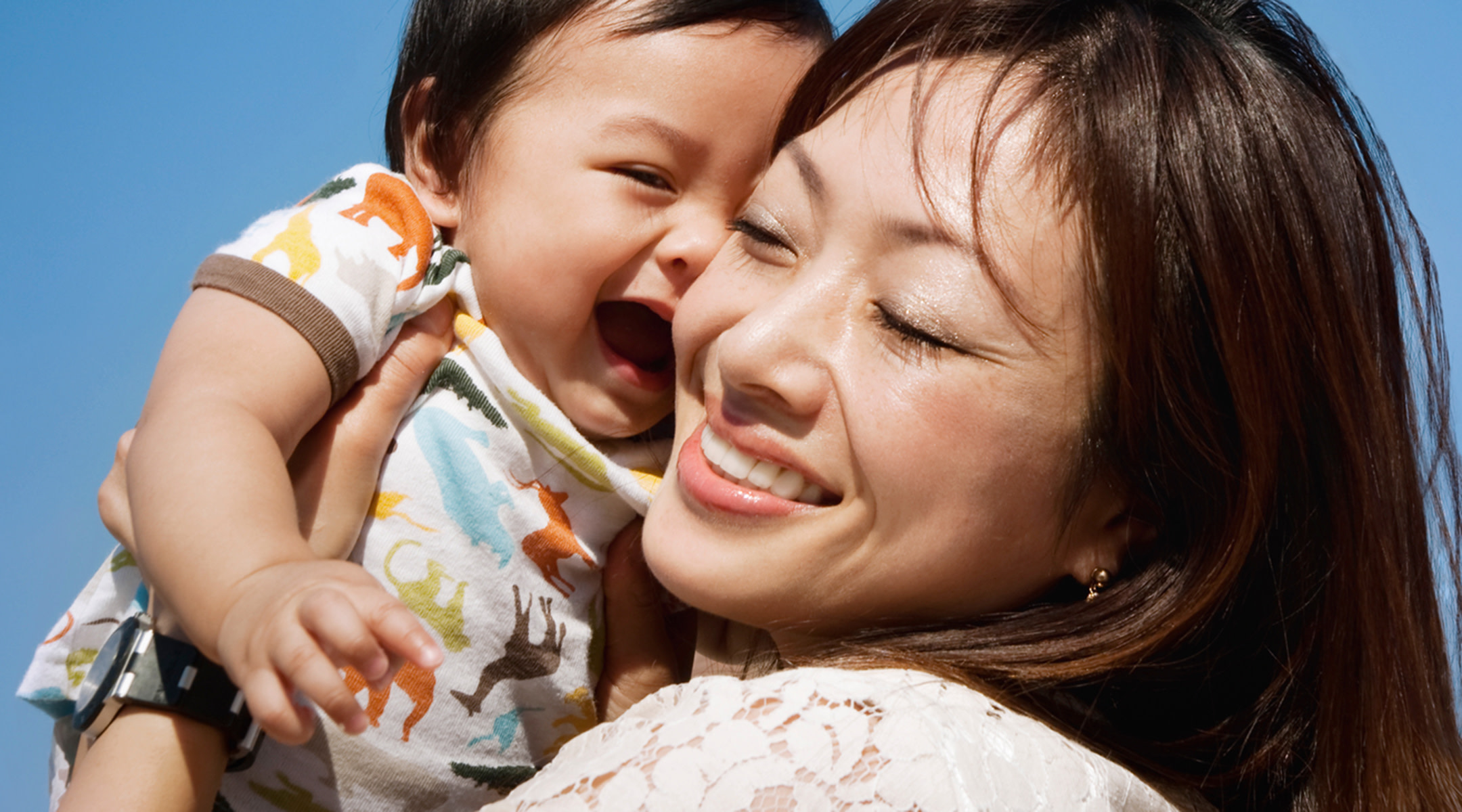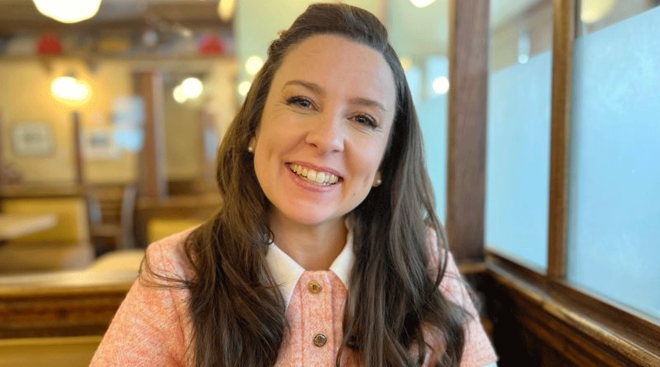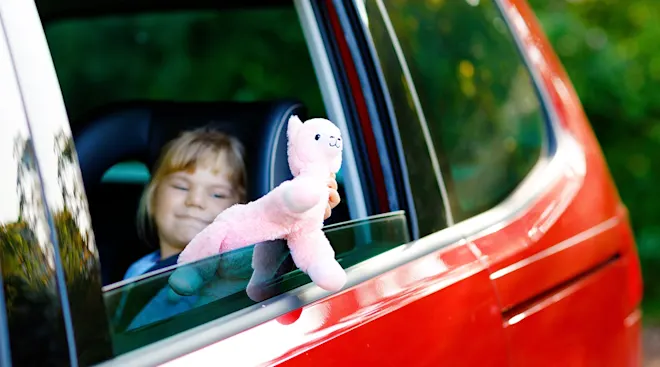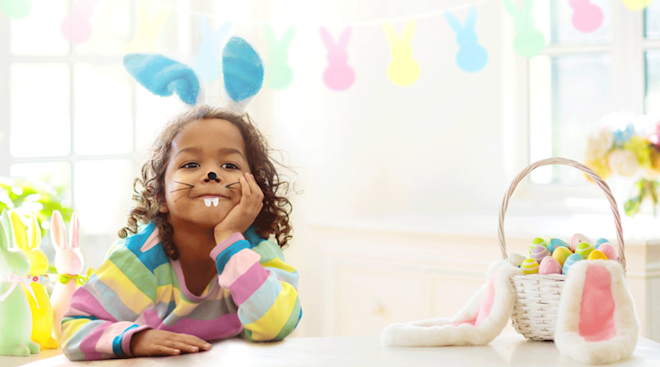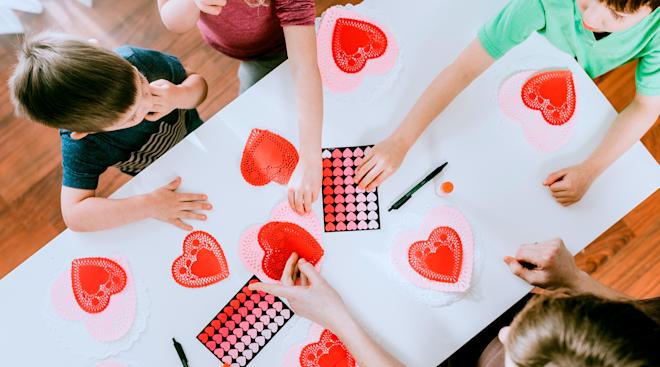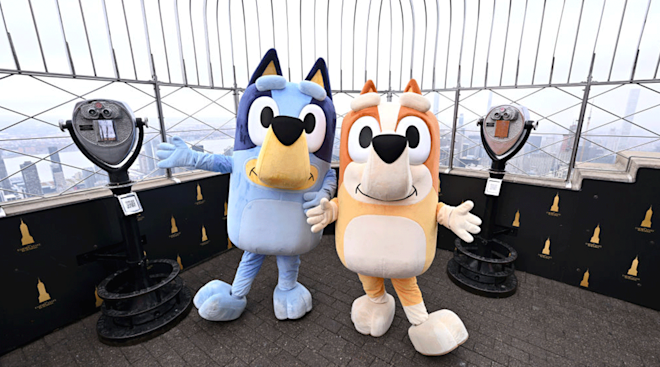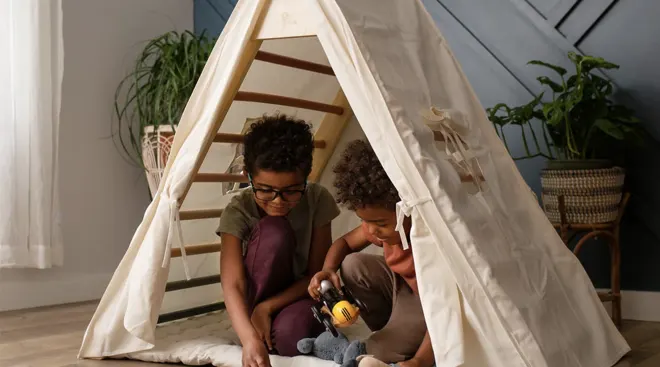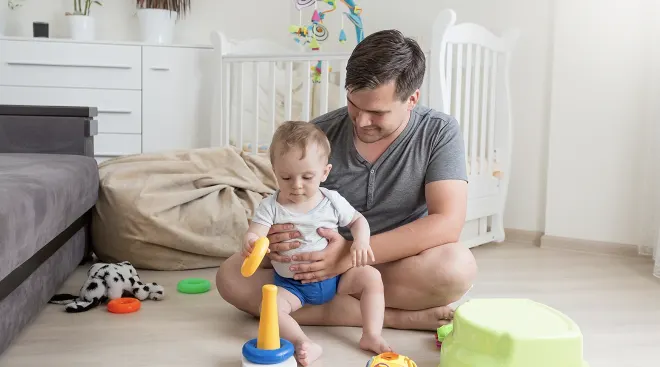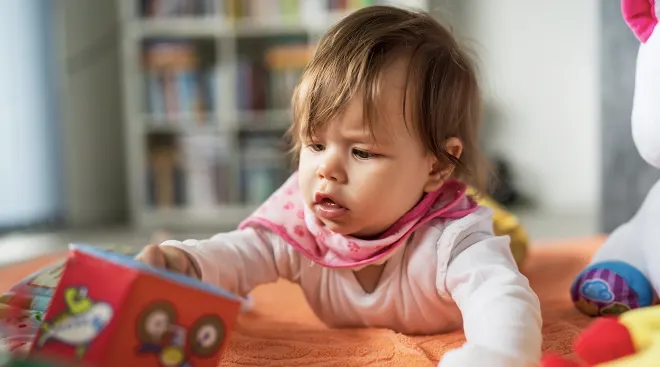25 Fun Things to Do With Babies and Toddlers
You know it’s important to play with baby—the right kind of play isn’t just fun, it’s also interesting, educational and a bonding experience. But figuring out how to interact with a scrunched-up newborn and how to happily occupy an unruly 14-month-old are their own unique challenges. That’s why we came up with this handy guide, covering activities for babies and toddlers from birth to age two.
Just one thing to keep in mind before you read: Babies develop at different rates so if your baby doesn’t seem ready for a certain activity, try it again in a month or two. Your baby also could downright hate an activity we suggest. That’s normal too! Feel free to improvise until you find something that makes you both happy.
Don’t break out the baby swing just yet. (And definitely stay away from playground swings for now!) Until baby gets better head control, try folding a bedsheet in half (twin or queen-size sheets work best) and then lay it on the ground and place baby in the middle. With an adult positioned at either end, pick up the ends of the bedsheet until baby is off the ground. Make sure baby is safely and securely resting inside and no parts of the sheet are covering her nose or mouth. “Swing the baby slowly to watch for her reaction,” says Kimberly Lyons, MEd, CMT, founder and owner of Tum e Time, a baby play center in San Francisco. “If your baby enjoys it, try singing a lullaby as they relax in the hammock.”
Good to know: This activity can help your baby build strong bones and muscles—and even better it just may soothe a fussy baby to sleep! Just be careful to swing gently and safely and don’t lift the sheet too high off the floor.
Babies love skin-to-skin contact, but you likely have too much to do to just sit and cuddle all day. A baby carrier, such as a ring sling or a strap-on front carrier, lets baby snuggle in close while freeing up your hands. Wearing baby also provides them with a wealth of stimulation. “Wearing babies allows them to see what you see. [They] begin to make sense of the world as you wear them while you work, clean and run errands,” says Bethany Gonzalez Moreno, founder of B. EcoChic, a company that helps parents find eco-friendly baby products.
Good to know: Young babies should be worn facing inward, not outward, to avoid overstimulation and so their head has proper support. Make sure baby has plenty of room to breathe while you’re carrying them.
“Very young babies are attracted to contrasting colors,” says Gaby Merediz, an artist, writer and mother of two young boys. “So draw some simple shapes in black marker on white paper and hang them above baby’s crib or on a spot on the wall near baby’s line of sight.”
Good to know: At birth, baby’s vision is limited, so they’ll have a hard time focusing on anything more than a few inches away from their face. Providing interesting objects in their line of sight encourages them to focus their eyes and strengthen their vision. Of course, you’re their very favorite “interesting object,” so make sure baby gets plenty of face time with you too!
Babies need tummy time to strengthen their back, neck and abdominal muscles, but many don’t like being placed facedown on the floor. So instead, try laying baby tummy-down on top of a soccer ball or kickball. “Hold baby securely and move them around in circles, forward and backward,” Lyons says. You can even place toys close to baby to encourage reaching for them, or set out an infant mirror so baby can see themself.
Good to know: Make sure the floor underneath the ball is carpeted or padded for safety’s sake.
At four months, babies are beginning to tune in to the different sounds that make up speech, so it’s a good idea to let talking take center stage. Baby is probably already making some distinct sounds, so pick one they say often and use it throughout the day in the words you say and the songs you sing. Yes, you can totally make this up. For example, if baby’s saying “da-da-da-da,” look at some pictures of Dad or sing the Star Wars theme song in your best “dah dah dah DAH dum” voice. You can switch it up—maybe use a different sound (dada, baba, chacha) every day to get baby hearing a variety of sounds to imitate.
Good to know: Copying baby’s sounds encourages them to make more. And as baby listens to you speak, they’ll begin to pick up other sounds and combinations of sounds. Before you know it, the two of you will be babbling back and forth.
This activity is virtually guaranteed to make baby giggle. Bonus: You’ll get a leg workout in the process. Start by sitting on the floor with your knees bent and feet flat on the floor in front of you. Place baby’s belly on your lower legs and hold onto their torso as you lie back on the ground. Baby will rise up into the air like an airplane. Then you can “rock your feet back and forth, move baby up and down or trace circles in the air,” Lyons says.
Good to know: The tummy-down position (and baby’s desire to see your face) can strengthen those core muscles, and they’ll love playing silly games of peek-a-boo as you move up and down.
Yes, baby can learn sign language this young. In fact, it’s an ideal time to start. Parents who have used American Sign Language with their babies say that those as young as six months can begin to understand simple signs (although baby may not begin to sign back until they’re eight months or older).
“Weave signs into everyday activities and eventually your child will be using signs, too,” says Moreno, who used sign language with her infant daughter. “Using sign language with baby helps children to think and express themselves symbolically, long before they can talk. We were able to teach our daughter over 350 American Sign Language signs by the time she was 17 months old. Once, when she was 12 months old, she asked me if the truck that had pulled up next to our car was an airplane.”
Good to know: Not sure where to start? Many communities offer baby sign language classes. Or look for a baby sign language book or video at your local library or online.
Have you noticed baby’s tendency to fling things from the high chair? Part of the thrill of that “game” (yes, to them it’s a game, while to you it can be aggravating) is simply getting to see what happens when a piece of food is thrown or dropped on the floor. Between six months and one year, babies are beginning to understand that their actions make things happen, and they’re studying those reactions. So why not set up your own action with a reaction? “Cut a hole in the plastic lid of a coffee can and give baby a few smaller toys,” Merediz says. “Help baby push the toys into the hole in the lid, and remove the lid to dump the toys out.” You’ll be surprised at how long you can keep baby entertained with this simple game.
Babies love to experiment with different sounds. For just one day, embrace the mess and pull the pots, pans and plastic containers out of the kitchen cupboards. Arm baby with a wooden spoon or plastic spatula, and demonstrate how to pound on the containers. Baby will have fun (cause and effect, remember?), make some scientific observations (pounding harder results in a louder noise)—and may even show some rhythm. Try turning on some music; a few babies will drum or sway right along with the beat.
Good to know: You can also try putting some uncooked beans or rice in different-size plastic containers and let your child shake the containers to make different noises. Just make sure they’re closed securely so baby doesn’t put things they’re not supposed to in their mouth. (Hint: duct tape works great.)
Or stuffed animals. Or plastic food. The actual toy doesn’t really matter; what matters is imagination, and props such as toys, stuffed animals and play food have long been used to inspire pretend play. “Starting at around nine months, many babies will enjoy rocking a baby doll or pretending to feed it, or pretending to talk on the phone,” says Jessica McMaken, owner of Razzbelly Early Childhood Consulting Services.
Good to know: You might feel kind of silly playing with dolls, but “old-fashioned imaginative play is critical for a child’s intellectual development,” McMaken says. “While engaged in pretend play, kids are learning to solve problems, practicing crucial social skills, developing self-confidence, mastering language skills and they can even practice literacy and numeracy skills.”
It’ll be awhile before baby will recite the 123s, but that doesn’t mean it’s too early to introduce numbers. So start counting things—anything and everything—with your child. Count cars. Balls. Babies. Apples. Stairs. What you count isn’t important. What’s important is that your child will be learning a very important mathematical concept called one-to-one correspondence.
Good to know: “One-to-one correspondence is the concept of matching one number to one object,” explains Laura Laing, author of Math for Grownups. “Kids aren’t born with the idea that the first car corresponds to one, and that the fifth car corresponds to five. It sounds ridiculous to us as adults, because we make the connection automatically. But it’s a pretty big deal to a little kid.”
You might think that laundry is a drag, but baby begs to differ. For some reason, babies are endlessly fascinated by anything in laundry baskets or hampers. So use that interest to your advantage. Bring up a big basket of clean laundry. “Let baby pull up on the side of the basket and explore the clothes inside,” says Brandi Fisher, a former early childhood educator. Want to have even more fun? Try balling up a sock and playing “catch." Or place baby in the laundry basket and push it around the room on the floor. You can even play hide-and-seek with the empty laundry basket and a pile of clean clothes.
Good to know: Pulling up helps baby strengthen their legs and refine their gross motor skills, and touching and feeling the clothes inside stimulates baby’s tactile senses.
“Simple wooden puzzles are great for children starting at one year of age, and they help to develop fine motor skills, hand-eye coordination and spatial awareness,” Moreno says. Start with puzzles with just a few pieces and chunky wooden handles, since the handles are easier for small, chubby hands to grasp than regular puzzle pieces.
Good to know: Rather than buying puzzles, you may also be able to find some at your local library. Many libraries offer puzzles for check out, or allow patrons to play with puzzles in the library.
Yes, you’ve made it to the age where you and baby (correction: toddler) can do crafts together. All you need is some tempera paint, plastic wrap and white paper. (Butcher paper works particularly well.) Cover your work surface and tape the white paper in place. Help your child dribble some paint onto the paper. Use several colors and let the colors touch. Then, lay a piece of plastic wrap directly on top of the paint, covering the paint and paper. Show your child how to move their hands over the paper to create designs in the paint; they’ll probably get the hang of it pretty quickly.
When they’re done, carefully lift off the plastic wrap and throw it away. Let the paint-and-paper dry; the finished product makes great gift wrap. Or you can frame the work of art.
Good to know: “My one-year-old loves making marbleized paper,” says Kate Freeman of Bright Horizons Family Solutions, a child care company. Kids love the tactile experience, and working with various colors helps them learn and ID colors (and even experiment with color mixing).
You’ve probably been on hundreds of walks with your child already. But how many times have you gone at their pace? Find out what sparks their interest when they’re given the time and space to explore whatever they want (within reason, of course—the road is still off-limits.).
Good to know: Too many kids spend the vast majority of their waking hours inside. Heading outside puts your child in touch with nature and gives them a chance to use their senses to explore the natural world. “Touch and explore the grass, trees and flowers. Watch bugs. Talk about what you see, hear, smell and feel,” McMaken says. “This activity stimulates language development, attention skills and observation skills. It also enhances the emotional connection between you and your child as you share the excitement of the outdoors.”
You already read to baby, but at this age, you might have a better time if you set aside time to just “look at books” instead of trying to go through the story word for word. So stock up on sturdy books and give your child a chance to hold and handle the book. At this age, kids are still learning basic concepts, so simply holding the book and learning (eventually) how to orient it right-side up and how to flip the pages from front to back is a huge pre-literacy skill that sets kids up for eventual school success.
Good to know: Follow your baby’s lead. If they’re interested in looking at the pictures, look at and label the pictures: “cat,” “cow,” “car.” You’ll help expand their vocabulary, and they’ll begin to understand that books represent things in the real world.
By now, your child has the physical dexterity to pick up and rearrange blocks, and may enjoy stacking them up and knocking them down. (Most toddlers love making messes!) Some kids like to use the blocks to create roadways and structures for cars and other toys too. Try putting out a variety of small toys with the blocks and see what your child does.
Good to know: “Blocks can be used to hone fine motor skills,” says Michele Morrison, director of training and program support for The Parent-Child Home Program in New York. “They’re also wonderful for looking at similarities and differences; try grouping them by size, shape or color. They can be used for counting activities and teaching basic directional concepts and colors too.”
Strap your child into their high chair or hold them on your lap and spread out some crayons and paper. Demonstrate how to make marks on the paper; then hand over a crayon. “Many parents get really upset with children having writing instruments at this age,” Morrison says. “They’re afraid that the child is going to start scribbling all over the place. But with supervision, a very young child can start using crayons.”
Good to know: Your pre-preschooler is nowhere near ready to write and probably not even close to creating artistic masterpieces, but your child will be developing fine motor skills and enjoying some self-expression. Eventually, those squiggles will turn into shapes and letters. For now, though, just have fun!
The old Mother Goose nursery rhymes can seem a little uncool, but they’re classics for a reason. “What’s wonderful about Mother Goose is the rhythm and the rhyme,” Morrison says. The classic rhymes also contain all kinds of unique and unusual vocabulary (tuffet, anyone?), which is great for your child’s cognitive and verbal development.
Good to know: “Studies have shown that the more words kids are exposed to, the better they typically do in school. So the more we can stretch their vocabulary, the better. And children between the ages of 16 and 24 months are real sponges for language. That’s when language is really blossoming, and a very important window in terms of child development.”
A small rubber ball is good for hours of fun. (Just make sure the ball is bigger than the inside of a cardboard paper towel tube. You don’t want your child playing with a potential choking hazard.) “Show your toddler how to kick, throw and chase the ball,” says McMaken. “They will be developing motor skills and also getting a pint-sized physics lesson as they observe the way the ball behaves under different forces.”
Good to know: Playing “catch” or “kick” with your kid also teaches the importance of sharing and taking turns—important concepts for soon-to-be preschoolers!
Toss some plastic measuring cups into the tub or kiddie pool to open up a whole new window of learning for your child. Let your child play, experiment and make observations. If you want to play along, try filling a half-cup container and pouring it into a one-cup container. Then fill the one-cup measure and have your child try to dump the contents into the half-cup container. It won’t fit!
Good to know: Your child will think you’re just having fun, but they will also be making some important observations. “What you’re doing is encouraging your child to develop a sense of size,” says Laing. “Eventually, they’ll understand that a half cup is smaller than one cup, and that one cup is bigger than a half cup.”
Toddlers love imitating their caregivers, so the next time you need to get something done around the house, try involving your child. “If you are wiping down the counters, give your tot a little rag and see what they do,” Fisher says. “Most likely, they’ll try to copy your motions and will soon be trying to wipe the floor, cabinets, toys—everything."
Good to know: Helping around the house helps kids develop motor skills, but more importantly, Fisher says, it helps them “feel important and gain independence.” Other developmentally appropriate household tasks: dusting, picking up toys, sweeping or vacuuming with parents.
Cardboard boxes are cheap, easy to find and endlessly entertaining—not to mention cognitively stimulating. “Children are little scientists,” Morrison says. “Many kids this age are fascinated with filling up boxes and dumping out boxes.” And while that can be annoying for parents (aka the Head Cleaner-Uppers), your little scientist is actually learning about cause and effect.
Good to know: Building with boxes can also help kids grasp complicated concepts. “One of the things that very young children are exploring is the idea of conceptual language, like inside and outside, on top of, underneath,” Morrison says. “They really get to experience that when playing with boxes.”
“Classic nursery rhymes and children’s songs like ‘This Little Piggy’ and ‘Five Monkeys on the Bed’ help kids understand basic mathematical concepts such as ‘taking away’ and ‘adding to,’” Laing says. “Kids this age aren’t going to be able to add and subtract, but they can begin to understand the concepts.”
Good to know: Combining the songs with the appropriate actions really drives home the message. So you’ll want to play with those piggies too.
Tearing is immensely satisfying for young kids, McMaken says, so show your toddler how to tear strips of paper from a piece of construction paper. If they’re interested, you can even show the, how to glue the torn pieces to another piece of paper. “This activity is useful for teaching color concepts,” McMaken explains. “It also develops fine motor skills which will become important for writing, and as a bonus, mastering the sequence of steps (tear, apply glue, place on paper) is important practice for later development of reading skills.”
Please note: The Bump and the materials and information it contains are not intended to, and do not constitute, medical or other health advice or diagnosis and should not be used as such. You should always consult with a qualified physician or health professional about your specific circumstances.
Plus, more from The Bump:
Navigate forward to interact with the calendar and select a date. Press the question mark key to get the keyboard shortcuts for changing dates.
































